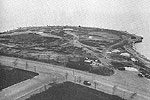|

South Lakefront
(continued)
Hyde Park began to take on the characteristics of a small New
England town, reflecting the background of most of its early residents.
The suburb even had a small commons located on 53rd Street and
the lakefront. Moreover, as with many other small towns, the train
depot became the center of activity. Before the town hall was
constructed, the IC Station served as a meeting place for community
organizations. By the late 1860s the entire township, stretching
to 130th Street, numbered about 3.000 people, and Paul Cornell
and other real estate developers began to look for ways to speed
up development on the South Side.
At the end of the Civil War, Cornell headed a group which called
for the creation of a park system south of Chicago. After suffering
several defeats, pro-park forces succeeded in getting a bill
through the Illinois General Assembly. Cornell was considered
the "father
of the South Park System," so it is not surprising that
his settlement was surrounded by the largest and most beautiful
of
the parks. Jackson Park and the Midway Plaisance formed
the southern boundary of Hyde Park, while Washington Park bordered
it on the west: thus the community took
on the appearance of an island surrounded by greenery (See
Fig. 1). The parks
became strong selling points for Hyde Park
developers, and years later they provided natural boundaries
between
Hyde Park and the economic and demographic changes going on around
it (See Fig. 2).
Meanwhile, transportation improved for Hyde Park residents.
In 1869, the same year the South Park System was created, the
Chicago
and Calumet Railroad began to run a "steam dummy" train
along 55th Street and up Cottage Grove Avenue. This rail line
connected with the horsecar line at 39th Street and provided
residents of western Hyde Park with easy access to Chicago.
In 1870 the
town had 1,000 inhabitants, while the township as a whole had
grown to 3,600. Cornell's original settlement continued to be
populated by businessmen and professionals, though others were
moving in to provide services for the middle class. In 1872
the
township was granted a "village" government by the
General Assembly in order to expand services for the growing
population.
«
previous
7
of 23
next
»
|
 |

|
 |


Figure 1:
Midway Plaisance, c. 1909.
»

Figure 2:
Promontory Point, 1937.
»
|